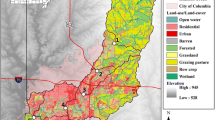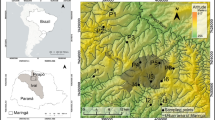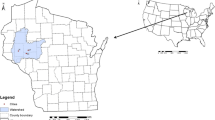Abstract
Watershed management and policies affecting downstream ecosystems benefit from identifying relationships between land cover and water quality. However, different data sources can create dissimilarities in land cover estimates and models that characterize ecosystem responses. We used a spatially balanced stream study (1) to effectively sample development and urban stressor gradients while representing the extent of a large coastal watershed (>4400 km2), (2) to document differences between estimates of watershed land cover using 30-m resolution national land cover database (NLCD) and <1-m resolution land cover data, and (3) to determine if predictive models and relationships between water quality and land cover differed when using these two land cover datasets. Increased concentrations of nutrients, anions, and cations had similarly significant correlations with increased watershed percent impervious cover (IC), regardless of data resolution. The NLCD underestimated percent forest for 71/76 sites by a mean of 11 % and overestimated percent wetlands for 71/76 sites by a mean of 8 %. The NLCD almost always underestimated IC at low development intensities and overestimated IC at high development intensities. As a result of underestimated IC, regression models using NLCD data predicted mean background concentrations of NO3 − and Cl− that were 475 and 177 %, respectively, of those predicted when using finer resolution land cover data. Our sampling design could help states and other agencies seeking to create monitoring programs and indicators responsive to anthropogenic impacts. Differences between land cover datasets could affect resource protection due to misguided management targets, watershed development and conservation practices, or water quality criteria.





Similar content being viewed by others
References
Alexander RB, Smith RA, Schwarz GE (2000) Effect of stream channel size on the delivery of nitrogen to the Gulf of Mexico. Nature 403:758–761
Angel S, Parent J, Civco DL, Blei A, Potere D (2011) The dimensions of global urban expansion: estimates and projections for all countries, 2000-2050. Prog Plan 75:53–107
APHA (American Public Health Association) (1998) Standard methods for the examination of water and wastewater, 20th edn. In: Clesceri LS, Greenberg LE, Eaton AD (eds.). American Public Health Association, Washington, DC
Ator SW, Olsen AR, Pitchford AM, Denver JM (2003) Application of a multipurpose unequal probability stream survey in the Mid-Atlantic coastal plain. J Am Water Resour Assoc 39:873–885
Bellucci CJ (2007) Stormwater and aquatic life: making the connection between impervious cover and aquatic life impairments for TMDL development in Connecticut streams. Proc. TMDL 2007:1003–1018
Biggs BJF (2000) Eutrophication of streams and rivers: dissolved nutrient–chlorophyll relationships for benthic algae. J N Am Benthol Soc 19:17–31
Booth DB, Jackson CR (1997) Urbanization of aquatic systems: degradation thresholds, stormwater detection and the limits of mitigation. J Am Water Resour Assoc 33:1077–1090
Booth DB, Hartley D, Jackson R (2002) Forest cover, impervious-surface area, and the mitigation of stormwater impacts. J Am Water Resour Assoc 38:835–845
Brabec EA (2009) Imperviousness and land-use policy: toward an effective approach to watershed planning. J Hydrol Eng 14:425–433
Brooks SS, Lake PS (2007) River restoration in Victoria, Australia: change is in the wind, and none too soon. Restor Ecol 15:584–591
Carpenter SR, Caraco NF, Correll DL, Howarth RW, Sharpley AN, Smith VH (1998) Nonpoint pollution of surface waters with phosphorus and nitrogen. Ecol Appl 8:559–568
Claggett PR, Okay JA, Stehman SV (2010) Monitoring regional riparian forest cover change using stratified sampling and multiresolution imagery. J Am Water Resour Assoc 46:334–343
Claggett PR, Irani FM, Thompson RL (2013) Estimating the extent of impervious surfaces and turf grass across large regions. J Am Water Resour Assoc 49:1057–1077
Congalton RG (1997) Exploring and evaluating the consequences of vector-to-raster and raster-to-vector conversion. Photogramm Eng Remote Sens 63:425–434
Cuffney TF, Brightbill RB, May JT, Waite IR (2010) Responses of benthic macroinvertebrates to environmental changes associated with urbanization in nine metropolitan areas. Ecol Appl 20:1384–1401
Deacutis CF (2008) Evidence of ecological impacts from excess nutrients in upper Narragansett Bay. In: Desbonnett A, Costa-Pierce BA (eds) Science of ecosystem-based management: Narragansett Bay in the 21st Century. Springer, Berlin
Detenbeck NE, Concotta D, Denver JM, Greenlee SK, Olsen AR, Pitchford AM (2005) Watershed-based survey designs. Environ Monit Assess 103:59–81
Detenbeck N, Rosiu C, Hayes L, Legros J (2014) Differentiating impacts of watershed development from superfund sites on stream macroinvertebrates. United States Environmental Protection Agency, Washington, EPA/600/R-13/352
Dodds WK, Oakes RM (2004) A technique for establishing reference nutrient concentrations across watersheds affected by humans. Limnol Oceanogr Methods 2:333–341
Duan SW, Kaushal SS, Groffman PM, Band LE, Belt KT (2012) Phosphorus export across an urban to rural gradient in the Chesapeake Bay watershed. J Geophys Res: Biogeosci. 11:G01025. doi:10.1029/2011JG001782
Fitzgerald EP, Bowden WB, Parker SP, Kline ML (2012) Urban impacts on streams are scale-dependent with nonlinear influences on their physical and biotic recovery in Vermont, United States. J Am Water Resour Assoc 48:679–697
Flint SA, McDowell WH (2015) Effects of headwater wetlands on dissolved nitrogen and dissolved organic carbon concentrations in a suburban New Hampshire watershed. Freshw Sci 34:456–471
Goetz SJ, Wright RK, Smith AJ, Zinecker E, Schaub E (2003) IKONOS imagery for resource management: tree cover, impervious surfaces, and riparian buffer analyses in the mid-Atlantic region. Remote Sens Environ 88:195–208
Gordon A, Simondson D, White M, Moilanen A, Bekessy SA (2009) Integrating conservation planning and landuse planning in urban landscapes. Landsc Urban Plan 91:183–194
Groffman PM, Law NL, Belt KT, Band E, Fisher GT (2004) Nitrogen fluxes and retention in urban watershed ecosystems. Ecosystems 7:393–403
Hale RL, Groffman PM (2006) Chloride effects on nitrogen dynamics in forested and suburban stream debris dams. J Environ Qual 35:2425–2432
Hassett BA, Palmer MA, Bernhardt ES (2007) Evaluating stream restoration in the Chesapeake Bay Watershed through practitioner interviews. Restor Ecol 15:563–572
Hatt BE, Fletcher RD, Walsh CJ, Taylor SL (2004) The influence of urban density and drainage infrastructure on the concentrations and loads of pollutants in small streams. Environ Manag 34:112–124
Herlihy AT, Larsen DP, Paulsen SG, Urquhart NS, Rosenbaum BJ (2000) Designing a spatially balanced, randomized site selection process for regional stream surveys: the EMAP Mid-Atlantic pilot study. Environ Monit Assess 63:95–113
Herlihy AT, Kamman NC, Sifneos JC, Charles D, Enache MD, Stevenson RJ (2013) Using multiple approaches to develop nutrient criteria for lakes in the conterminous USA. Freshw Sci 32:367–384
Higgins CL, Wilde GR (2005) The role of salinity in structuring fish assemblages in a prairie stream system. Hydrobiologia 549:197–203
Hogan DM, Jarnagin ST, Loperfido JV, Van Ness K (2014) Mitigating the effects of landscape development on streams in urbanizing watersheds. J Am Water Resour Assoc 50:163–178
Hollister JW, Gonzalez ML, Paul JF, August PV, Copeland JL (2004) Assessing the accuracy of national land cover dataset area estimates at multiple spatial extents. Photogramm Eng Remote Sens 70:405–414
Horrigan N, Choy S, Marshall J, Recknagel F (2005) Response of stream macroinvertebrates to changes in salinity and the development of a salinity index. Mar Freshw Res 56:825–833
Jantz P, Goetz SJ, Jantz C (2005) Urbanization and the loss of resource lands in the Chesapeake Bay watershed. Environ Manag 36:808–825
Jones JW, Jarnagin T (2009) Evaluation of a moderate resolution, satellite-based impervious surface map using an independent, high-resolution validation data set. J Hydrol Eng 14:369–376
Kaushal SS, Groffman PM, Likens GE, Belt KT, Stack WP, Kelly VR, Band LE, Fisher GT (2005) Increased salinization of fresh water in the northeastern United States. Proc Natl Acad Sci USA 102:13517–13520
Kaushal SS, Likens GE, Utz RM, Pace ML, Grese M, Yepsen M (2013) Increased river alkalinization in the Eastern U.S. Environ Sci Technol 47:10302–10311
King RS, Baker ME, Kazyak PF, Weller DE (2011) How novel is too novel? Stream community thresholds at exceptionally low levels of catchment urbanization. Ecol Appl 21:1659–1678
Knox AK, Dahgren RA, Tate KW, Atwill ER (2008) Efficacy of natural wetlands to retain nutrient, sediment and microbial pollutants. J Environ Qual 37:1837–1846
Lehto LLP, Hill BH (2013) The effect of catchment urbanization on nutrient uptake and biofilm enzyme activity in Lake Superior (USA) tributary streams. Hydrobiologia 713:35–51
Li W, Saphores JDM, Gillespie TW (2015) A comparison of the economic benefits of urban green spaces estimated with NDVI and with high-resolution land cover data. Landsc Urban Plan 133:105–117
Meyer JL, Paul MJ, Taulbee WK (2005) Stream ecosystem function in urbanizing landscapes. J N Am Benthol Soc 24:602–612
Miltner RJ (2010) A method and rationale for deriving nutrient criteria for small rivers and streams in Ohio. Environ Manag 45:842–855
Miltner RJ, White D, Yoder C (2004) The biotic integrity of streams in urban and suburbanizing landscapes. Landsc Environ Plan 69:87–100
Moglen GE, Kim S (2007) Limiting imperviousness—are threshold-based policies a good idea? J Am Plan Assoc 73:161–171
Moore AA, Palmer MA (2005) Invertebrate biodiversity in agricultural and urban headwater streams: implications for conservation and management. Ecol Appl 15:1169–1177
Mulholland PJ, Helton AM, Poole GC, Hall RO, Hamilton SK, Peterson BJ, Tank JL, Ashkenas LR, Cooper LW, Dahm CN, Dodds WK, Findlay SEG, Gregory SV, Grimm NB, Johnson SL, McDowell WH, Meyer JL, Valett HM, Webster JR, Arango CP, Beaulieu JJ, Bernot MJ, Burgin AJ, Crenshaw CL, Johnson LT, Niederlehner BR, O’Brien JM, Potter JD, Sheibley RW, Sobota DJ, Thomas SM (2008) Stream denitrification across biomes and its response to anthropogenic nitrate loading. Nature 452:202–206
Nowak DJ, Greenfield EJ (2010) Evaluating the national land cover database tree canopy and impervious cover estimates across the conterminous United States: a comparison with photo-interpreted estimates. Environ Manag 46:378–390
O’Brien PJ, Wehr JD (2010) Periphyton biomass and ecological stoichiometry in streams within an urban to rural land-use gradient. Hydrobiologia 657:89–105
Olsen AR, Stevens DL, Larsen DP (1999) Statistical issues for monitoring ecological and natural resources in the United States. Environ Monit Assess 54:1–45
Paul MJ, Meyer JL (2001) Streams in the urban landscape. Ann Rev Ecol Systematics 32:333–365
Peterson BJ, Wollheim WM, Mulholland PJ, Webster JR, Meyer JL, Tank JL, Marti E, Bowden WB, Valett HM, Hershey AE, McDowell WH, Dodds WK, Hamilton SK, Gregory S, Morrall DD (2001) Control of nitrogen export from watersheds by headwater streams. Science 292:86–90
Pickett STA, Buckley GL, Kaushal SS, Williams Y (2011) Social-ecological science in the humane metropolis. Urban Ecosyst 14:319–339
Potapova MG, Charles DF (2003) Distribution of benthic diatoms in US rivers ain relation to conductivity and ionic composition. Freshw Biol 48:1311–1328
Raney SM, Eimers MC (2014) A comparison of nutrient export at two agricultural catchments: insight into the effect of increasing urban land cover in southern Ontario. Hydrol Process 28:4328–4339
Schueler TR, Fraley-McNeal L, Cappiella K (2009) Is impervious cover still important? Review of recent research. J Hydrol Eng 14:309–315
Seitzinger SP, Styles RV, Boyer EW, Alexander RB, Billen G, Howarth RW, Mayer B, Van Breemen N (2002) Nitrogen retention in rivers: model development and application to watersheds in the northeastern USA. Biogeochemistry 57:199–237
Seto KC, Fragkias M, Guneralp B, Reilly MK (2011) A meta-analysis of global urban land expansion. PLoS One 6:e23777
Smith ML, Zhou WQ, Cadenasso M, Grove M, Band LE (2010) Evaluation of the national land cover database for hydrologic application in urban and suburban Baltimore, Maryland. J Am Water Resour Assoc 46:429–442
Smucker NJ, Detenbeck NE (2014) Meta-analysis of lost ecosystem attributes in urban streams and the effectiveness of out-of-channel management practices. Restor Ecol 22:741–748
Smucker NJ, Becker M, Detenbeck NE, Morrison AC (2013a) Using algal metrics and biomass to evaluate multiple ways of defining concentration-based nutrient criteria in streams and their ecological relevance. Ecol Indic 32:51–61
Smucker NJ, Detenbeck NE, Morrison AC (2013b) Diatom responses to watershed development and potential moderating effects of near-stream forest and wetland cover. Freshw Sci 32:230–249
Stehman SV (1999) Basic probability sampling designs for thematic map accuracy assessments. Int J Remote Sens 20:2423–2441
Stevens DL (1997) Variable density grid-based sampling designs for continuous spatial populations. Environmetrics 8:167–195
Stevens DL, Olsen AR (2004) Spatially balanced sampling of natural resources. J Am Stat Assoc 99:262–278
Sudduth EB, Perakis SS, Bernhardt ES (2013) Nitrate in watersheds: straight from soils to streams? J Geophys Res: Biogeosci 118:291–302
Theobald DM, Stevens DL, White D, Urquhart NS, Olsen AR, Norman JB (2007) Using GIS to generate spatially balanced random survey designs for natural resource applications. Environ Manag 40:134–146
Tiner RW (2003) Geographically isolated wetlands of the United States. Wetlands 23:494–516
Tippler C, Wright IA, Davies PJ, Hanion A (2014) The influence of concrete on the geochemical qualities of urban streams. Mar Freshw Res 65:1009–1017
Tu J, **a ZG, Clarke KC, Frei A (2007) Impact of urban sprawl on water quality in eastern Massachusetts, USA. Environ Manag 40:183–200
Tzoulas K, Korpela K, Venn S, Yli-Pelkonen V, Kazmierczak A, Niemela J, James P (2007) Promoting ecosystem and human health in urban areas using green infrastructure: a literature review. Landsc Urban Plan 81:167–178
US EPA (2002) 2000 National water quality inventory. EPA-841-R-02-001. Office of Water, US Environmental Protection Agency, Washington, DC
US EPA (2007) National Estuary Program Coastal Condition Report. EPA 842-F-06-001. Office of Water/Office of Research and Development, US Environmental Protection Agency, Washington, DC
Us EPA (2011) Approved general-purpose methods. US Environmental Protection Agency, Washington, DC
US EPA (2015) Connectivity of streams and wetlands to downstream waters: a review and synthesis of the scientific evidence. U.S. Environmental Protection Agency, Washington, DC, EPA/600/R-14/475F
Walsh CJ, Roy AH, Feminella JW, Cottingham PD, Groffman PM, Morgan RP (2005) The urban stream syndrome: current knowledge and the search for a cure. J N Am Benthol Soc 24:706–723
Weber T, Sloan A, Wolf J (2006) Maryland’s green infrastructure assessment: development of a comprehensive approach to land conservation. Landsc Urban Plan 77:94–110
White EM, Morzillo AT, Alig RJ (2009) Past and projected rural land conversion in the US at state, regional, and national levels. Landsc Urban Plan 89:37–48
Wickham JD, Ritters KH, Wade TG, Vogt P (2010a) A national assessment of green infrastructure and change for the conterminous United States using morphological image processing. Landsc Urban Plan 94:186–195
Wickham JD, Stehman SV, Fry JA, Smith JH, Homer CG (2010b) Thematic accuracy of the NLCD 2001 land cover for the conterminous United States. Remote Sens Environ 114:1286–1296
Wickham JD, Stehman SV, Gass L, Dewitz J, Fry JA, Wade TG (2013) Accuracy assessment of NLCD 2006 land cover and impervious surface. Remote Sens Environ 130:294–304
Williams M, Hopkinson C, Rastetter E, Vallino J, Claessens L (2005) Relationships of land use and stream solute concentrations in the Ipswich River Basin, Northeastern Massachusetts. Water Air Soil Pollut 161:55–74
Withers PJA, Jarvie HP (2008) Delivery and cycling of phosphorus in rivers: a review. Sci Total Environ 400:379–395
Wolch JR, Byrne J, Newell JP (2014) Urban green space, public health, and environmental justice: the challenge of making cities ‘just green enough’. Landsc Urban Plan 125:234–244
Acknowledgments
Emily Seelen and Joe Bishop assisted with field sampling and laboratory processing of samples. Comments on an earlier draft by Jeff Hollister, Taylor Jarnagin, Betty Kreakie, James Lake, Anthony Olsen, and Glen Thursby are greatly appreciated. NJS research (1) was supported in part by an appointment to the Oak Ridge Institute for Science and Education participant research program supported by an interagency agreement between the United States Environmental Protection Agency (EPA) and Department of Energy and (2) may not necessarily reflect the views of EPA, and no official endorsement should be inferred. Research described in this article has been funded by the EPA, and this manuscript, tracking number ORD-10047, has been reviewed by the Atlantic Ecology Division and approved for publication. Mention of trade names or commercial products does not constitute endorsement or recommendation for use.
Author information
Authors and Affiliations
Corresponding author
Rights and permissions
About this article
Cite this article
Smucker, N.J., Kuhn, A., Charpentier, M.A. et al. Quantifying Urban Watershed Stressor Gradients and Evaluating How Different Land Cover Datasets Affect Stream Management. Environmental Management 57, 683–695 (2016). https://doi.org/10.1007/s00267-015-0629-3
Received:
Accepted:
Published:
Issue Date:
DOI: https://doi.org/10.1007/s00267-015-0629-3




